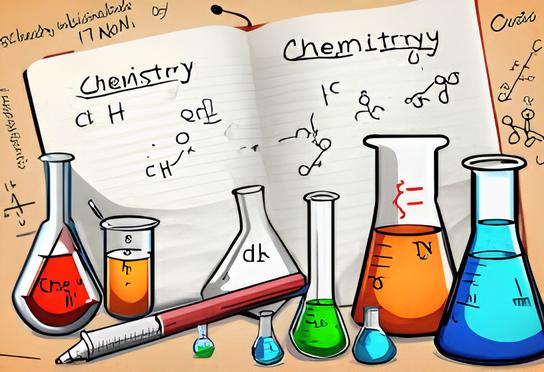JAMB CHEMISTRY – Oxygen and its Compounds
Table of Contents
- Key Points
- Introduction to Oxygen
- Properties and Occurrence
- Importance and Compounds
- Comprehensive Note on Oxygen and Its Compounds
- Key Citations
Key Points
- Oxygen, with atomic number 8, is a vital gas making up 21% of Earth’s atmosphere, essential for life and industry.
- It forms various compounds like water (H₂O), carbon dioxide (CO₂), and oxides, crucial for biological processes and chemical reactions.
- Research suggests oxygen’s role in respiration and photosynthesis supports life, while industrial uses include steelmaking and medical oxygen therapy.
- The evidence leans toward oxygen’s allotropes, like ozone (O₃), protecting against UV radiation, though ground-level ozone can be harmful.
Introduction to Oxygen
Oxygen is a fundamental element, symbolized as “O” and with an atomic number of 8, belonging to Group 16 (chalcogens) in the periodic table. It is a highly reactive nonmetal, existing as a colorless, odorless, and tasteless gas at standard temperature and pressure, comprising about 21% of Earth’s atmosphere. Its significance spans biological systems, supporting respiration, and industrial applications, such as steel production.
Properties and Occurrence
Oxygen’s physical properties include a melting point of -218.79°C and a boiling point of -182.962°C, with a density of 1.429 g/L as a gas. Chemically, it is highly electronegative (3.44 on the Pauling scale), forming strong bonds and acting as a potent oxidizing agent. It has stable isotopes like O-16 (99.76%) and occurs abundantly in the Earth’s crust (46.6% by mass) and water (88.8% by mass).
Importance and Compounds
Oxygen is essential for aerobic respiration, where it helps produce energy in cells, and is produced by photosynthesis in plants. Industrially, it’s used in steelmaking, chemical synthesis, and medical applications. Its compounds, such as water, carbon dioxide, and various oxides, play critical roles in life and industry, with unexpected details like ozone’s dual role as a protective layer and a pollutant.
Comprehensive Note on Oxygen and Its Compounds
Introduction
Oxygen, with the symbol “O” and atomic number 8, is a member of the chalcogen group (Group 16) in the periodic table. It is a highly reactive nonmetal, essential for life, and constitutes about 21% of Earth’s atmosphere by volume. Discovered independently by Carl Wilhelm Scheele and Joseph Priestley in the 1770s, oxygen’s role in respiration and combustion was pivotal in shaping modern chemistry, as formalized by Antoine Lavoisier. This note explores oxygen’s properties, occurrence, allotropes, and the diverse compounds it forms, highlighting their biological, industrial, and environmental significance.
Properties of Oxygen
Oxygen exhibits a range of physical and chemical properties that underpin its reactivity and utility.
Physical Properties
At standard temperature and pressure (STP), oxygen is a gas, colorless, odorless, and tasteless. Its physical properties include:
- Melting Point: -218.79°C (54.36 K)
- Boiling Point: -182.962°C (90.188 K)
- Density: 1.429 g/L at STP (gas), 1.141 g/cm³ when liquid at boiling point
- Solubility in Water: Moderately soluble, with 14.6 mg/L at 0°C, varying with temperature (e.g., 9.0 mL/L in freshwater at 5°C, 6.04 mL/L at 25°C)
- Appearance: Colorless gas, pale blue in liquid and solid states
A detailed table of thermal and physical properties is provided below for clarity:
| Property | Value |
|---|---|
| Triple Point | 54.361 K, 0.1463 kPa |
| Critical Point | 154.581 K, 5.043 MPa |
| Heat of Fusion (O₂) | 0.444 kJ/mol |
| Heat of Vaporization (O₂) | 6.82 kJ/mol |
| Molar Heat Capacity (O₂) | 29.378 J/(mol·K) |
| Thermal Conductivity | 26.58×10⁻³ W/(m·K) |
| Speed of Sound (gas, at 27°C) | 330 m/s |
Chemical Properties
Oxygen is highly reactive due to its electronegativity of 3.44 (Pauling scale), forming compounds with most elements except noble gases like helium, neon, and argon under standard conditions. It is a strong oxidizing agent, accepting electrons in reactions, and supports combustion. Its ground state is triplet oxygen (O₂), paramagnetic due to unpaired electrons, while singlet oxygen is a higher-energy, more reactive form.
- Oxidation States: Commonly -2 (e.g., in oxides), -1 (in peroxides), and 0 (in O₂).
- Reactivity: Reacts spontaneously with many organic compounds at room temperature in autoxidation, forming oxides.
Isotopes
Oxygen has three stable isotopes: O-16 (99.76% natural abundance), O-17 (0.04%), and O-18 (0.20%). Additionally, there are 15 known radioisotopes, with O-15 being the most stable (half-life 122.24 seconds). These isotopes are crucial for paleoclimatology, where the ratio of O-18 to O-16 in marine organism shells helps reconstruct past climates.
Occurrence
Oxygen is ubiquitous in nature, reflecting its abundance and reactivity:
- Atmosphere: Constitutes 20.95% by molar fraction, essential for respiration and produced by photosynthesis.
- Earth’s Crust: The most abundant element, making up 46.6% by mass, primarily as oxides (e.g., SiO₂, Fe₂O₃) and silicates.
- Hydrosphere: Found in water (H₂O), accounting for 88.8% of its mass, and in dissolved form in oceans, supporting marine life.
- Biological Systems: Integral to biomolecules like carbohydrates, proteins, and lipids, and essential for cellular respiration.
Allotropes
Oxygen exists in several allotropic forms, each with distinct properties:
- Diatomic Oxygen (O₂): The stable, most common form, with a bond order of 2 and paramagnetic due to unpaired electrons. It is critical for respiration and combustion, with a bond length of 121 pm and bond energy of 498 kJ/mol.
- Ozone (O₃): A triatomic, bent molecule, highly reactive and a strong oxidant. It forms naturally in the stratosphere, absorbing UVB and UVC radiation, forming the ozone layer (Oxygen). However, ground-level ozone is a pollutant, contributing to smog and respiratory issues.
- Tetraoxygen (O₄): A metastable form discovered in 2001, with potential applications as a rocket fuel oxidizer due to its high energy content.
- Metallic Oxygen: At pressures above 96 GPa, oxygen transitions to a metallic phase, exhibiting superconductivity at low temperatures, a finding with implications for materials science.
Oxygen Compounds
Oxygen’s reactivity leads to a vast array of compounds, classified by structure and properties. Below, we detail key categories, with examples and uses.
Oxides
Oxides are binary compounds of oxygen with another element, categorized by their chemical behavior:
- Basic Oxides: Formed by metals, especially alkali and alkaline earth metals, reacting with water to form hydroxides. Examples include:
- Sodium oxide (Na₂O) + H₂O → 2NaOH
- Calcium oxide (CaO) + H₂O → Ca(OH)₂ (slaked lime, used in construction)
- Acidic Oxides: Formed by non-metals, reacting with water to form acids. Examples include:
- Carbon dioxide (CO₂) + H₂O ⇌ H₂CO₃ (carbonic acid, contributes to ocean acidification)
- Sulfur dioxide (SO₂) + H₂O → H₂SO₃ (sulfurous acid, precursor to acid rain)
- Amphoteric Oxides: Exhibit both acidic and basic properties, formed by elements like aluminum and zinc. Examples:
- Aluminum oxide (Al₂O₃): Reacts with acids (Al₂O₃ + 6HCl → 2AlCl₃ + 3H₂O) and bases (Al₂O₃ + 2NaOH + 3H₂O → 2NaAl(OH)₄)
- Zinc oxide (ZnO): Used in pharmaceuticals and as a pigment
- Neutral Oxides: Neither acidic nor basic, do not react with water to form acids or bases. Examples:
- Carbon monoxide (CO): A toxic gas, used in metallurgy
- Nitric oxide (NO): A signaling molecule in biology, also a pollutant
Water (H₂O)
Water is the most abundant oxygen compound, essential for life. Its structure is bent, with a bond angle of 104.5° due to lone pairs on oxygen, making it polar and capable of hydrogen bonding. Key properties include:
- High boiling point (100°C) and heat capacity, enabling it to moderate Earth’s climate
- Universal solvent, dissolving many substances due to polarity
- Exists in solid (ice), liquid, and gas (steam) states, with unique density behavior (ice floats due to lower density)
- Importance: Constitutes ~60% of the human body, medium for biochemical reactions, and critical for ecosystems
Peroxides and Superoxides
- Peroxides: Contain the O₂²⁻ ion, with oxygen in the -1 oxidation state. Examples:
- Hydrogen peroxide (H₂O₂): A strong oxidant, used as a disinfectant, bleach, and in rocket propulsion
- Sodium peroxide (Na₂O₂): Reacts with CO₂ to release O₂, used in breathing apparatuses
- Superoxides: Contain the O₂⁻ ion, with oxygen in the -½ oxidation state. Examples:
- Potassium superoxide (KO₂): Orange-yellow solid, used in self-contained breathing devices, reacts with CO₂ to produce O₂ (4KO₂ + 2CO₂ → 2K₂CO₃ + 3O₂)
Hydroxides
Hydroxides contain the OH⁻ ion, typically formed from basic oxides or metal reactions with water. Examples:
- Sodium hydroxide (NaOH): Strong base, used in soap making, paper production, and chemical synthesis
- Calcium hydroxide (Ca(OH)₂): Known as slaked lime, used in construction, agriculture, and water treatment
Organic Oxygen Compounds
Oxygen is integral to organic chemistry, forming compounds essential for life and industry:
- Alcohols: Contain -OH group, e.g., methanol (CH₃OH, solvent), ethanol (C₂H₅OH, beverage, fuel)
- Ethers: Contain C-O-C linkage, e.g., diethyl ether (C₂H₅OC₂H₅, anesthetic)
- Aldehydes: Contain -CHO group, e.g., formaldehyde (HCHO, preservative), acetaldehyde (CH₃CHO, chemical intermediate)
- Ketones: Contain >C=O group, e.g., acetone (CH₃COCH₃, solvent, nail polish remover)
- Carboxylic Acids: Contain -COOH group, e.g., acetic acid (CH₃COOH, vinegar), formic acid (HCOOH, ant sting component)
- Esters: Contain -COOR group, e.g., ethyl acetate (CH₃COOC₂H₅, solvent, flavoring)
- Amides: Contain -CONH₂ group, e.g., acetamide (CH₃CONH₂, used in organic synthesis)
These compounds are vital in biochemistry (e.g., glucose, amino acids) and industry (e.g., plastics, pharmaceuticals).
Biological and Industrial Importance
Oxygen’s role extends beyond chemistry into biology and industry, with significant implications:
- Biological Importance: Essential for aerobic respiration, where it acts as the final electron acceptor in the electron transport chain, producing ATP. Photosynthesis by plants, algae, and cyanobacteria (6CO₂ + 6H₂O + light → C₆H₁₂O₆ + 6O₂) replenishes atmospheric oxygen, balancing the oxygen cycle. It is also a component of biomolecules like carbohydrates, proteins, and nucleic acids.
- Industrial Importance: Used in steelmaking to oxidize impurities, in chemical synthesis (e.g., ethylene oxide for antifreeze, peracetic acid for disinfectants), medical oxygen therapy for respiratory conditions, and as an oxidizer in rocket propellants (e.g., liquid oxygen, LOX, in space programs). It is also used in wastewater treatment and oxy-acetylene welding.
Environmental Impact
Oxygen’s environmental role is multifaceted:
- Ozone Layer: Stratospheric ozone (O₃) absorbs harmful UVB and UVC radiation, protecting life from UV damage. However, its depletion, notably the “ozone hole,” is a concern, linked to chlorofluorocarbons (CFCs), with international efforts like the Montreal Protocol addressing it (Oxygen).
- Ground-Level Ozone: A pollutant formed by reactions of nitrogen oxides and volatile organic compounds, contributing to smog and respiratory issues, contrasting with its protective role aloft.
- Oxygen Cycle: Maintains atmospheric oxygen levels through photosynthesis and respiration, with dissolved oxygen in water bodies supporting aquatic life, assessed by biochemical oxygen demand (BOD) for water quality.
Conclusion
Oxygen, with its diverse properties and compounds, is indispensable for life, industry, and environmental processes. From simple oxides to complex organic molecules, its reactivity and abundance shape the natural world, with ongoing research into its atmospheric and industrial applications continuing to reveal its multifaceted role.
Key Citations
- Oxygen – Element information, properties and uses | Periodic Table
- What is Oxygen? (O) – Element Information, Properties & Uses with Videos
- Oxygen | Discovery, Symbol, Properties, Uses, & Facts | Britannica
- A Guide to the Physical and Chemical Properties of Oxygen – Unacademy
- Oxygen (O) – Chemical properties, Health and Environmental effects
- Oxygen (O) – Discovery, Occurrence, Production, Properties and Applications of Oxygen
- What is Oxygen? Physical and Chemical Properties of Oxygen – Hamilton Company
- Oxygen compounds – Wikipedia
- Oxygen – Energy Education
- 18.9: Occurrence, Preparation, and Compounds of Oxygen – Chemistry LibreTexts





